
Gyudon (牛丼) is one of the classic comfort foods in Japanese cuisine that’s also become popular overseas (think Yoshinoya). It’s a quick, hearty Japanese beef rice bowl that’s extremely simple to put together—a nutritious and budget-friendly meal that’s always satisfying. While every household in Japan makes gyudon a little differently, I’ll show you my favorite version of this weeknight favorite that I make at home!
If you love Japanese rice bowls, try my Oyakodon, Unadon, and Katsudon recipes next!
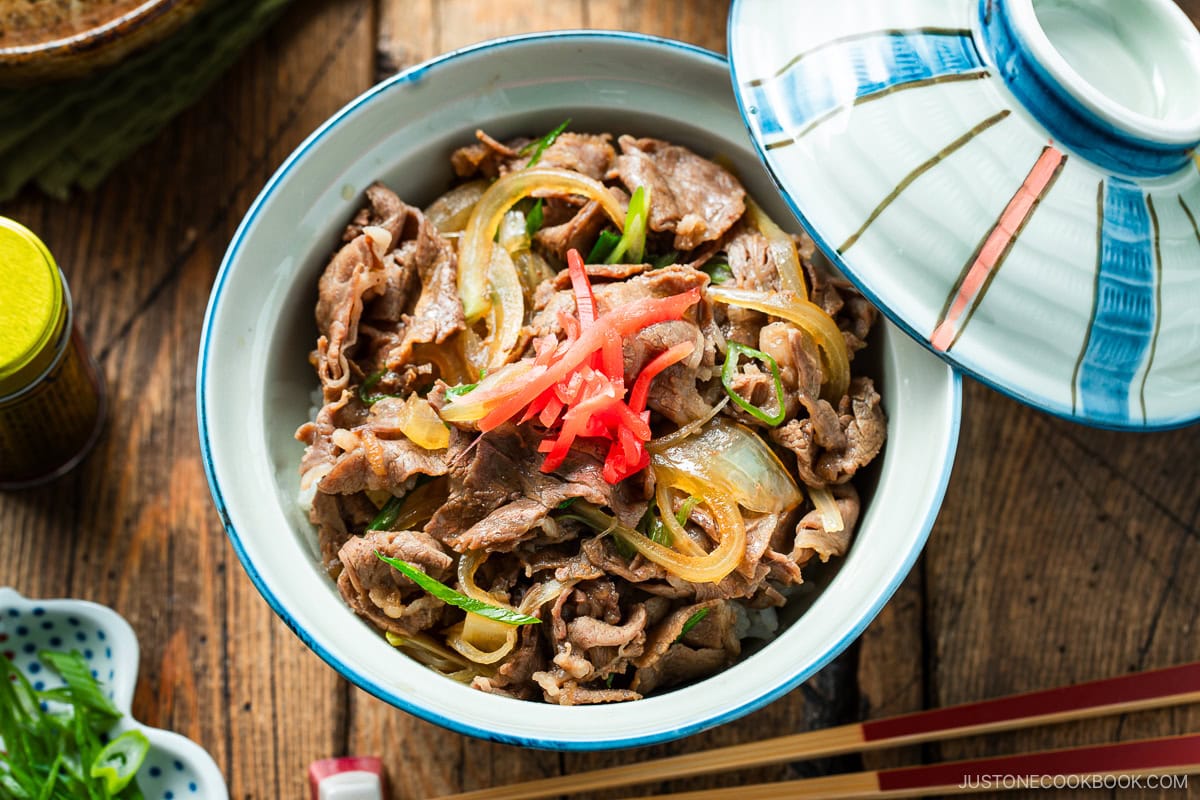
What is Gyudon?
The gyudon that we love today originated in the later part of the 19th century with the arrival of Western culture. That’s when a popular beef hot pot dish called gyunabe (牛鍋) was first served in Yokohama in 1862. When people began pouring the gyunabe broth over their rice, the dish was coined gyumeshi (牛飯). In the late 1800s, it was eventually renamed gyudon, with gyu (牛) for beef and don (丼) referring to the donburi rice bowl.


Ingredients for Gyudon
- Thinly sliced beef (chuck or ribeye)
- Onion
- Green onion/scallion
- Cooked Japanese short-grain rice
- Pickled red ginger (beni shoga or kizami beni shoga) – for garnish
- Sauce:
- Dashi (Japanese soup stock)
- Sake
- Mirin
- Soy sauce
- Sugar – to taste
Find the printable recipe with measurements below.
Jump to RecipeSubstitutions
- Thinly sliced beef: The paperthin sliced beef I use in the recipe is sold in Japanese and Asian groceries. If you can’t find it, you can also learn How To Slice Meat Thinly at home with my tutorial.
- Dashi: Japanese soup stock is essential for an authentic taste. I recommend making standard Awase Dashi from scratch or using a convenient dashi packet for the best result. You could also use dashi powder in a pinch.
- Sake: If you don’t have Japanese sake at home, try substituting dry sherry or Chinese rice wine. For a non-alcohol version, simply replace with water.
- Mirin: To skip the mirin, you can use 2 Tbsp sake/water + 2 tsp sugar for every 2 tablespoons of mirin.
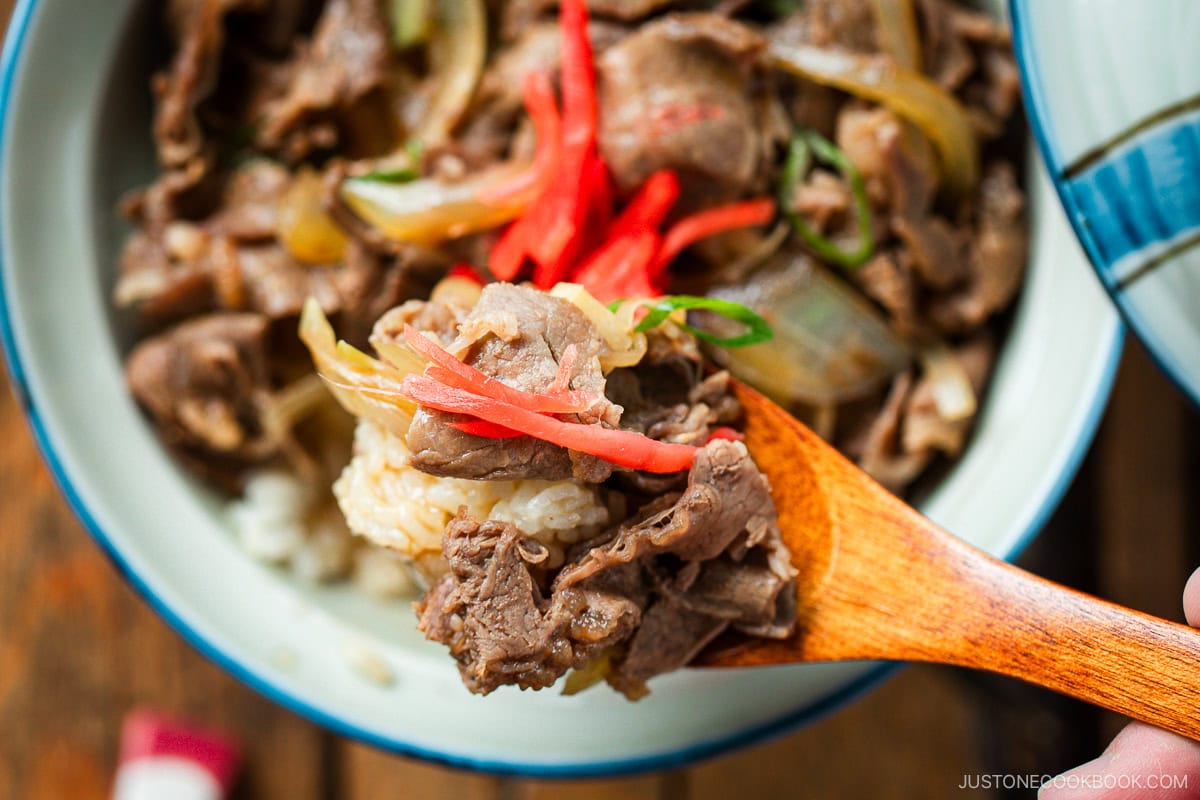
How to Make Gyudon
Preparation
- Cut the onions and beef. Thinly slice the onion and green onion/scallion. Then, remove the thinly sliced beef from the freezer when it’s semi-frozen and slice the meat into pieces 3 inches (7.6 cm) wide.


- Add the seasonings to the cold pan. To a large frying pan (do not turn on the heat yet), add the dashi, sake, mirin, soy sauce, and sugar. Stir to combine.


- Layer the onions and meat in the pan. Scatter the onion slices into the sauce around the pan, separating the layers. Next, place the meat on top, separating the thin slices of beef so the meat covers the onions.


Cooking
- Cover the pan with a lid and turn on the heat. Start cooking over medium heat. Once simmering, turn down the heat and cook, covered, for 3–4 minutes. Once in a while, open the lid and skim off the scum and fat from the broth with a fine-mesh skimmer.


Assemble
- Ladle over a bowl of hot steamed rice. Sprinkle the green onions on top and cook covered for another minute. Serve the steamed rice in large donburi bowls and spoon the beef and onions on top. Drizzle with some of the dashi broth and top with red pickled ginger. Serve immediately.


Nami’s Recipe Tips
- Thinly slice the onion so it becomes tender and sweeter quickly. I love the natural sweetness that the cooked onions impart to the dish.
- Use good-quality beef. Well-marbled beef will not become chewy after simmering in the sauce. Therefore, I highly recommend ribeye for gyudon. If you can’t find pre-sliced beef, read my tutorial (How To Slice Meat Thinly) to learn how to do it at home.
- Make extra dashi (Japanese soup stock) so you can use it for both the gyudon and some miso soup to go with the meal. For the best result, I recommend making dashi either from scratch or with a dashi packet.
- Cook more rice than usual. Rice bowl dishes called donburi typically serve more rice per serving, typically 1⅔ cups (250 g), to go with the food on top. Therefore, please prepare a little bit more than usual. I always make 1½ rice cooker cups for two servings and 3 rice cooker cups for four servings.
- Don’t overcook the beef, especially if your meat is not well-marbled. You don’t want chewy meat. I always stop cooking as soon as the beef is no longer pink. If the meat is well-marbled, you can let it simmer slightly longer to allow the meat to absorb more flavors from the sauce.


Variations and Customizations
Gyudon is a simple dish that you can easily enhance with other ingredients. Here are a few of my suggestions.
- Serve it with an egg. In Japan, it’s popular to serve gyudon with different types of eggs to add richness and protein. When we place a raw egg yolk in the center of the simmered beef, we call it tsukimi gyudon (お月見牛丼). I love adding a poached egg on top for gyudon with Onsen Tamago (温玉のせ牛丼) (you can also use my 2-Minute Microwave Onsen Tamago recipe). Finally, in Tanindon (他人丼) or gyutojidon (牛とじ丼), we drizzle beaten eggs over the simmered beef and cook covered until eggs are still runny but just set, similar to oyakodon.
- Make it sukiyaki style. Known as Kansai-style gyudon, this variation is cooked in the manner of that region’s sukiyaki where the sugar is sprinkled on the thin-sliced raw beef before it’s cooked and simmered with the other seasonings. Interestingly, Kansai-style gyudon does not always require dashi; therefore, the flavor is more intense. I grew up eating gyudon at home this way, as my grandmother and mother were raised in the Kansai cities of Nara and Osaka, respectively. You can find the cooking steps for my original 2011 beef bowl recipe Kansai Sukiyaki-style Gyudon in the Notes section of the recipe card below.
- Make it with chicken. If you want to change up the protein, I recommend making it with chicken and drizzling beaten egg into the pan toward the end of cooking. Now, you’ve made Oyakodon! See my recipe on the blog for complete instructions.
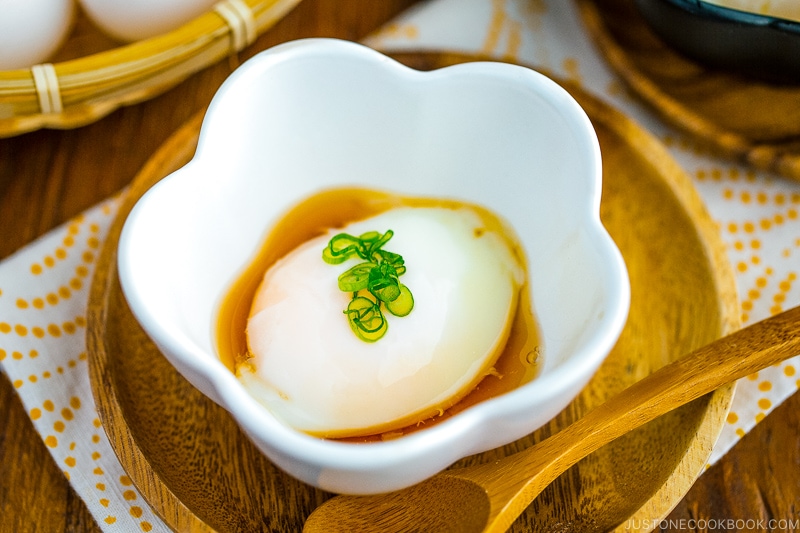
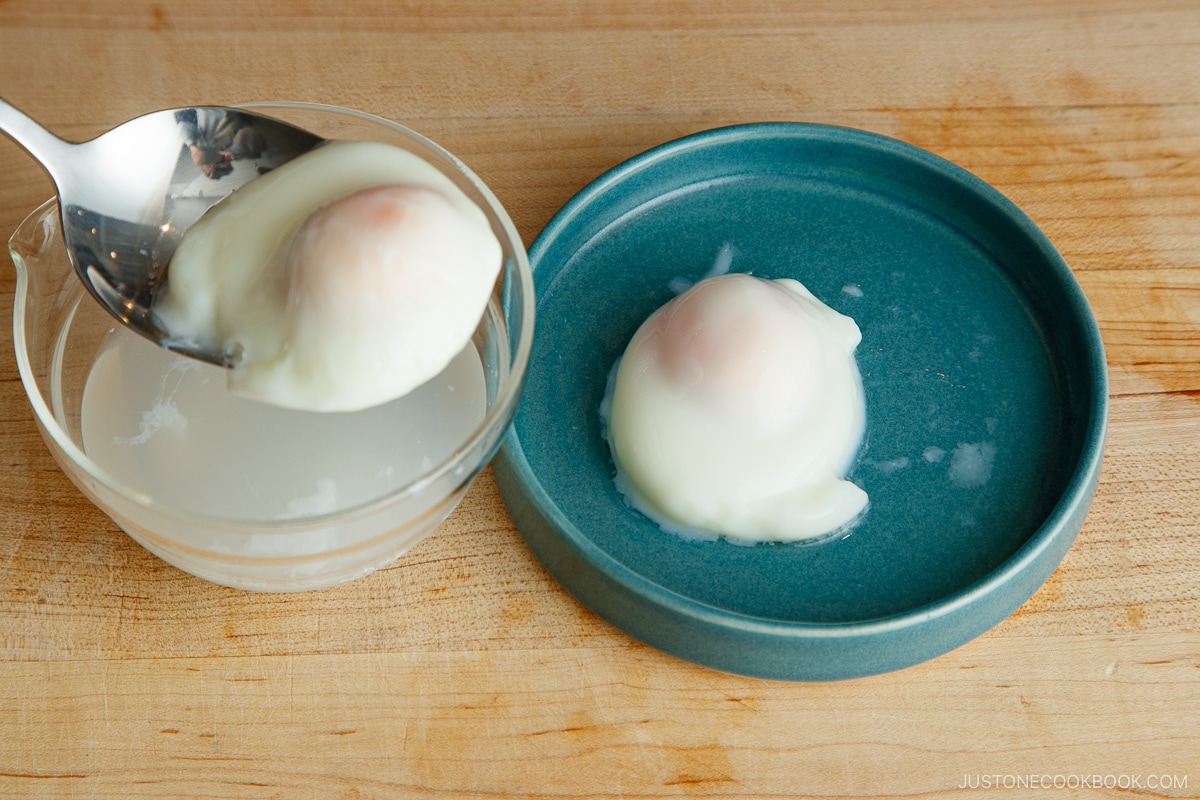


What to Serve with Gyudon
Gyudon is a hearty one-bowl meal that you can serve on its own. To add variety and extra nourishment, I suggest pairing it with these following dishes.
- With soup – Add seasonal produce to your meal with my versatile Vegetable Miso Soup.
- With a side dish – Kinpira Gobo is a great make-ahead side dish to round out the meal.
- With a salad – Broccolini Gomaae is a vegetable recipe that goes well with everything.
- With pickles – I love to serve refreshing Japanese Pickled Cabbage to contrast with the richness of the beef.



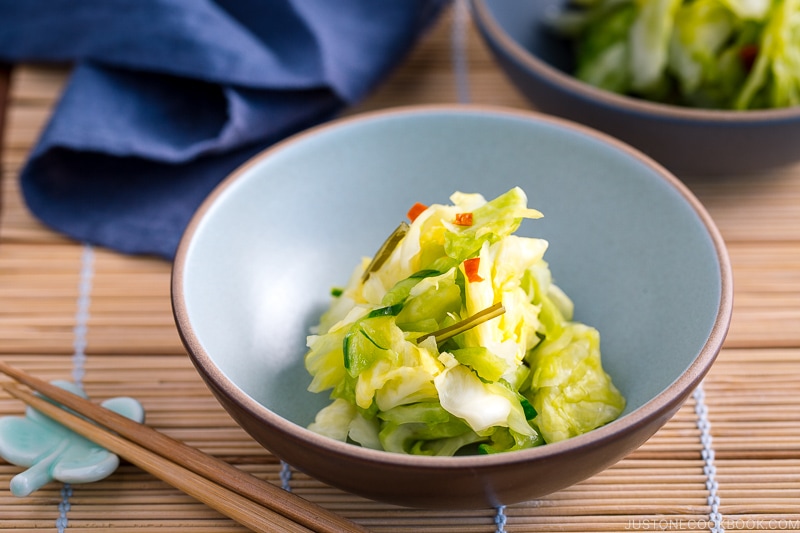
Storage and Reheating Tips
To store: You can keep any leftover beef and onion mixture in an airtight container and store in the refrigerator for up to 2–3 days. You can also store it in the freezer for up to 3–4 weeks.
To reheat: Heat gently in a saucepan with the simmering liquid until warm.
Frequently Asked Questions
You may have used meat that is not well-marbled. To avoid chewy beef, please stop cooking as soon as the beef is no longer pink. Also, please use paperthin slices of well-marbled beef. If the meat is well-marbled, you can let it simmer slightly longer to allow the meat to absorb more flavors from the sauce.
Gyudon (Japanese Beef Rice Bowl)
Ingredients
- ½ onion (4 oz, 113 g)
- 1 green onion/scallion
- ½ lb thinly sliced beef (such as ribeye) (you can also slice your own meat)
For the Sauce
- ½ cup dashi (Japanese soup stock) (use standard Awase Dashi, dashi packet or powder, or Vegan Dashi)
- 2 Tbsp sake (substitute with dry sherry or Chinese rice wine, or use water for a non-alcohol version)
- 2 Tbsp mirin (or use 2 Tbsp sake/water + 2 tsp sugar)
- 3 Tbsp soy sauce
- 1 Tbsp sugar (to taste)
For Serving
- 2 servings cooked Japanese short-grain rice (typically 1⅔ cups (250 g) per donburi serving)
- pickled red ginger (beni shoga or kizami beni shoga) (to garnish)
Instructions
Before You Start…
- For the steamed rice, please note that 1½ cups (2 rice cooker cups, 300 g) of uncooked Japanese short-grain rice yield 4⅓ cups (660 g) of cooked rice, enough for 2 donburi servings (3⅓ cups, 500 g). See how to cook short-grain rice with a rice cooker, pot over the stove, Instant Pot, or donabe.

- Gather all the ingredients. I usually put the thinly sliced beef in the freezer for 10 minutes because it‘s a lot easier to cut semi-frozen meat.

To Prepare the Ingredients
- First, thinly slice ½ onion.
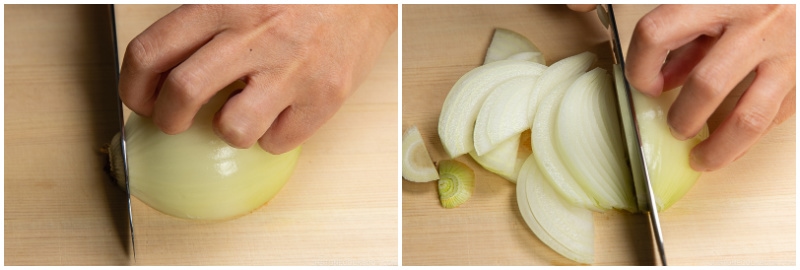
- Next, cut 1 green onion/scallion diagonally into thin slices. Set aside.

- Then, remove ½ lb thinly sliced beef (such as ribeye) from the freezer. Cut the semi-frozen meat into pieces 3 inches (7.6 cm) wide.

- In a large frying pan (do not turn on the heat yet), add ½ cup dashi (Japanese soup stock), 2 Tbsp sake, 2 Tbsp mirin, 3 Tbsp soy sauce, and 1 Tbsp sugar. Stir to combine and dissolve the sugar.

- Next, add the onion slices and spread them in the broth throughout the pan, separating the onion layers.

- Then, distribute the meat on top of the onions. Separate the thin slices of beef so the meat covers the onions.

To Cook
- Cover the pan with a lid. Now, turn on the heat to medium and start cooking. Once simmering, turn down the heat to simmer and cook, covered, for 3–4 minutes.

- While simmering, open the lid and skim off the scum and fat from the broth once or twice with a fine-mesh skimmer (find it on Amazon and JOC Goods).

- Sprinkle the green onions on top and cook covered for another minute. Optional: If you would like to add beaten eggs, you can do it now (refer to my Tanindon recipe for detailed instructions).

To Serve
- Divide 2 servings cooked Japanese short-grain rice into large donburi bowls. Then, drizzle some of the pan sauce on top of the rice.

- Put the beef and onion mixture on top of the rice. If you’d like, drizzle additional remaining sauce on top. Top the gyudon with pickled red ginger (beni shoga or kizami beni shoga). Enjoy!

To Store
- You can keep any leftover beef and egg mixture in an airtight container and store in the refrigerator for up to 2–3 days and in the freezer for up to 3–4 weeks.
Notes
Nutrition
Did you make this recipe?
Tag @justonecookbook on Instagram so we can see your delicious creation!
Editor’s Note: The post was originally published on January 13, 2011. The recipe was revised on April 17, 2022. The post was republished with a new video on April 5, 2024, and with more helpful content on December 15, 2024.



